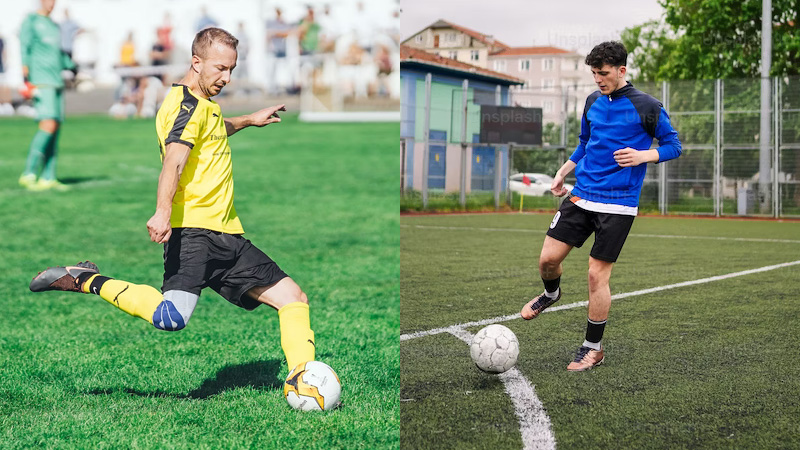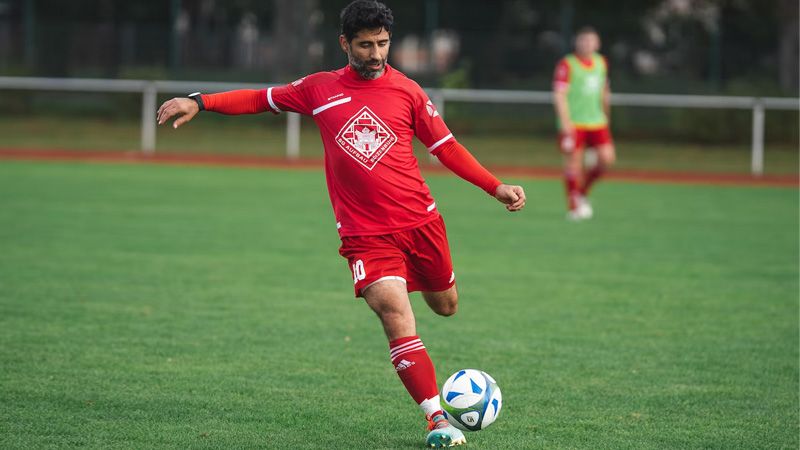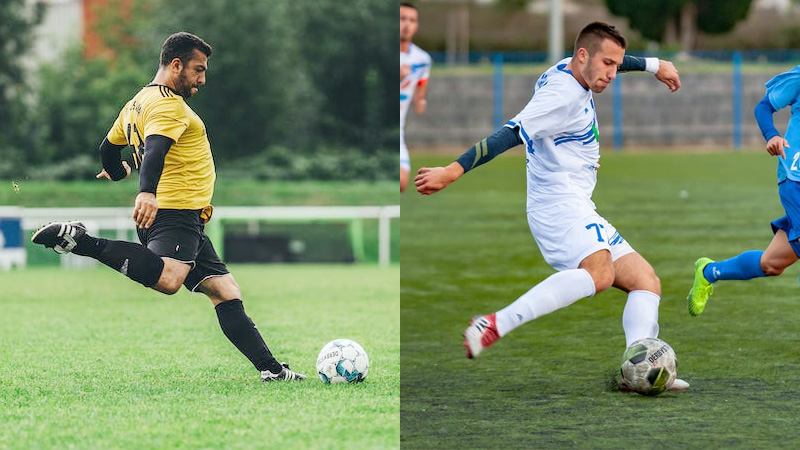Soccer, also known as football in many parts of the world, is a sport loved by millions for its exhilarating moments and breathtaking skills.
One of the fundamental techniques in soccer is the instep kick and pass, a crucial skill that allows players to deliver precise and powerful strikes on the ball.
As one of the most versatile moves in a player’s arsenal, mastering the instep kick opens up a world of possibilities, from long-range passes to potent shots on goal.
Whether you’re a beginner or a seasoned player looking to improve your kicking ability, mastering the instep kick and pass can significantly elevate your game.
In this article, we will delve into soccer instep kick and pass and tips to help you perfect this essential aspect of soccer.
Soccer Instep Kick and Pass
The instep kick, commonly referred to as the “laces” or “inside-of-foot” kick, is a technique where the player uses the top surface of their foot to strike the ball with precision and power. This method is widely employed in various situations during a soccer match, including shooting on goal, long passes, and clearing the ball.
Technique
Begin by positioning your body directly behind the ball. Take a few steps back to create space for a running approach. The non-kicking foot should be placed beside the ball, with toes pointing toward the target.
As you approach the ball, plant your non-kicking foot firmly beside the ball, maintaining a slight distance from it. This foot acts as a guide and helps you maintain balance during the kick.
Swing your kicking leg back, keeping it slightly bent at the knee. Aim to strike the ball with the laces (the area of your foot just below the toes) while keeping your ankle locked. Make sure to follow through after contact with the ball, extending your leg fully to maximize power and accuracy.
Tips
- Eyes on the Ball: Keep your eyes on the ball throughout the entire process, from approach to follow-through. This helps you maintain focus and ensure a clean connection.
- Lean Slightly Forward: Leaning slightly forward as you strike the ball helps you maintain balance and prevents your shot from soaring too high.
- Timing and Practice: Timing is crucial for a successful instep kick. Regular practice is essential to develop muscle memory and refine your technique.
Mastering the Instep Pass
The instep pass is an essential skill in soccer, allowing players to accurately distribute the ball to teammates over both short and long distances. Proper technique and timing are vital to ensure the pass reaches its intended recipient.
Technique
Stand with your feet shoulder-width apart, facing the direction you intend to pass the ball. Distribute your weight evenly on both feet. Similar to the instep kick, use the laces of your foot to strike the center of the ball.
Keep your passing foot pointed toward the target and your ankle locked. As you make contact, follow through in the direction of the pass.
Tips
- Weight Transfer: Transfer your weight from your non-kicking foot to your kicking foot during the pass. This generates power and helps maintain control over the ball.
- Accuracy Over Power: While power is essential for long-distance passes, focus on accuracy for shorter passes. Proper technique and a softer touch ensure the ball reaches your teammate accurately.
- Passing Angles: Consider the angle and speed required for the pass based on the positions of your teammates and opponents. A well-timed pass can create scoring opportunities and break through the defense.
How to Master Instep Kick and Pass?

Mastering the instep kick and pass in soccer requires dedication, practice, and attention to detail. Here’s a step-by-step guide to help you improve your skills and become proficient in executing the instep kick and pass:
Understand the Technique
Study the proper technique for the instep kick and pass, as outlined in the previous article. Pay attention to body positioning, foot placement, and striking the ball with the laces. Watch professional soccer players execute these techniques in matches and analyze their form and execution.
Start Slow and Controlled
Begin with slow and controlled practice to build muscle memory and develop the correct technique. Focus on accuracy rather than power in the initial stages. Once you have mastered accuracy, you can work on adding more power to your kicks and passes.
Consistent Practice
Regular practice is essential to improve your instep kick and pass. Set aside time each week to work on these skills.
Practice in different scenarios, such as stationary kicks, running kicks, and passing to a moving target.
Use Both Feet
Work on using both your dominant and non-dominant foot for instep kicks and passes. Being proficient with both feet makes you a more versatile player and harder to defend against.
Develop Leg Strength
Strengthen your leg muscles through targeted exercises like squats, lunges, and calf raises. Strong legs contribute to more powerful kicks and passes.
Receive Feedback
Seek feedback from coaches, teammates, or experienced players. They can provide valuable insights and correct any flaws in your technique. Consider recording yourself during practice sessions to analyze your form and identify areas for improvement.
Work on Timing
Mastering the instep kick and pass requires good timing. Practice your timing in different game situations, such as passing under pressure or shooting on the run.
Visualize Success
Visualization can be a powerful tool for improvement. Imagine yourself executing the perfect instep kick and pass in a game scenario. Positive visualization can help boost your confidence and focus.
Play Small-Sided Games
Participate in small-sided games with friends or teammates. This allows you to practice your instep kick and pass in a more dynamic and realistic setting. Small-sided games also help improve your decision-making and spatial awareness.
Stay Patient and Persistent
Mastering the instep kick and pass may not happen overnight. Stay patient and continue practicing consistently. Embrace mistakes as part of the learning process and use them as opportunities to improve.
Remember, becoming proficient in the instep kick and pass requires time and effort. Stay committed to your training, stay positive, and you will see significant progress in your soccer skills over time.
Other Types of Kicks in Soccer

In soccer, players have various types of kicks at their disposal, each serving specific purposes during a match. Here are some of the other types of kicks commonly used in soccer:
Inside-of-Foot Pass (Push Pass)
The inside-of-foot pass is one of the most basic and frequently used passes in soccer. Players use the inside of their foot to pass the ball to a teammate, especially in short and precise situations.
It offers accuracy and control, making it effective for maintaining possession and quick ball movement.
Outside-of-Foot Pass (Slice Pass)
The outside-of-foot pass involves using the outer edge of the foot to deliver the ball to a teammate. This pass is often used when players need to curve the ball around opponents or when they are in an awkward body position for an inside pass.
It’s a useful pass for getting around defenders and creating scoring opportunities.
Chip (Lofted Pass/Kick)
The chip is a lofted pass or kick that involves lifting the ball into the air over a short distance. Players use the toe or the inside of the foot to create backspin, causing the ball to travel in an arc.
Chips are helpful for passing over an opponent’s leg or delivering the ball to a teammate behind a defensive line.
Half-Volley
The half-volley is a technique where a player strikes the ball just after it bounces off the ground. It requires precise timing and skill. Players use the half-volley for shots on goal, clearances, and quick passes when the ball is at an awkward height.
Volley
The volley is a spectacular kick in which the player strikes the ball out of the air before it touches the ground. It demands excellent timing and technique. Volley shots are often seen during a shooting on goal, particularly from long-range or crossing situations.
Bicycle Kick (Overhead Kick)
The bicycle kick is an acrobatic move where a player throws their body into the air, and with their back to the goal, kicks the ball backward or sideways. Bicycle kicks are used for shooting on goal or clearing the ball from dangerous areas.
Free Kick
Free kicks are awarded to a team when the opposition commits a foul. They allow the attacking team to take a direct shot on goal or deliver a precise pass.
Free kicks demand precision and power, and players often employ various techniques like bending the ball (curving it) or going for pure power.
Penalty Kick
A penalty kick is awarded to the attacking team if a defending player commits a foul inside their own penalty area. It’s a one-on-one situation between the kicker and the goalkeeper, and accuracy is crucial in scoring from the penalty spot.
Each type of kick requires specific skills and techniques, and players must practice regularly to become proficient in executing them effectively during a game.
FAQs
What is the difference between the instep kick and other types of kicks in soccer?
The instep kick, also known as the laces or inside-of-foot kick, involves striking the ball with the top surface of the foot, using the area just below the toes. It is commonly used for shooting on goal, long passes, and clearances.
Can I use the instep kick for short passes, or is it only for long passes and shooting?
While the instep kick is commonly associated with long passes and shooting, it can also be used for short passes. However, for short-distance passes, using the inside-of-foot pass is often more accurate and easier to control. The instep pass is better suited for medium to long-range passes, as it allows for more power and precision over greater distances.
How do I improve the power and accuracy of my instep kick?
Improving the power and accuracy of your instep kick requires consistent practice and attention to technique. Focus on the following: proper technique, leg strength, and practice regularly.
Should I strike the ball with my toe or the laces during an instep kick?
When executing an instep kick, you should strike the ball with the laces area of your foot, which is the region just below your toes. Striking with the laces allows for a larger surface area to make contact with the ball, resulting in a more powerful and controlled shot or pass.
Is it essential to follow through after an instep kick?
Yes, following through after an instep kick is crucial for maximizing power and accuracy. After making contact with the ball, extend your kicking leg fully in the direction you want the ball to go. This follow-through motion helps generate power and ensures the ball maintains the desired trajectory.
Final Words
The soccer instep kick and pass are fundamental skills in soccer that every player should master. Through consistent practice, proper technique, and attention to detail, you can significantly improve your kicking ability and contribute effectively to your team’s success.
This essential skill involves striking the ball with the laces of the foot, maximizing accuracy and velocity. Whether it’s a precise through ball to split the defense or a swerving shot that finds the top corner of the net, the instep kick demands finesse and technique.
Remember, Rome wasn’t built in a day, and becoming proficient in the instep kick and pass may take time. So, get out there on the field, put these tips into action, and enjoy the journey of becoming a better soccer player!







